Content:
- Tips for winter grayling fishing
- Winter fly fishing Clothing
- Grayling tackle requirements for Winter
- When to go fishing
- How to find grayling in winter
- Grayling fly fishing methods and flies
Fishing is a yearlong obsession, and my year wouldn’t be complete without a hefty dose of winter fly fishing for grayling.
Grayling feed throughout the winter, even on the coldest of days. So they’re in peak condition for spring because, unlike the other members of the salmonoid family, they are spring spawners.
Also, it keeps me in practice for the start of the trout fishing season in March.
Braving these cold months will produce some memorable grayling fishing experiences, with the possibility of catching the fish of a lifetime.
Many years ago, I set myself a target of fly fishing at least once a week, almost irrespective of the weather.
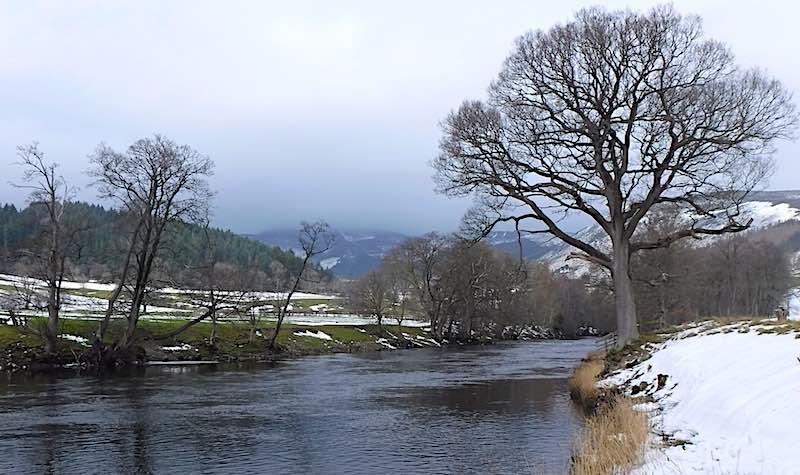
Sometimes in atrocious sub-zero temperatures, which I have to confess I now avoid because most of the day was spent…
freezing my fingers by de-icing the rod rings.
This challenge, through trial and error, has taught me plenty about fly fishing for grayling.
My aim in this article is to share my grayling fishing tips to help the beginner bypass a lot of trial and error.
Let’s begin by covering my…
Winter fly fishing essential tips for Grayling
First and foremost is…
Wrap-up WARM to keep the COLD OUT.
Because once your hands and feet start to sting with cold everything else will go to pot and you will just want to quit and go home to warm up!
Winter fly fishing clothing, waders and gloves
In the UK, the air temperature rarely gets into double figures from December and in January and February is close to or below zero.
When I’m wearing several layers of clothing to stay warm the first part of my body that gets cold first are my hands, which are followed by my feet and legs.
Winter fly fishing gloves are essential items
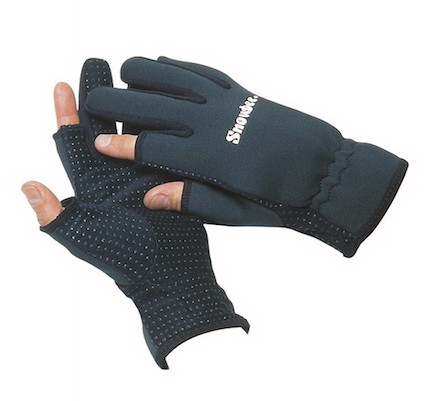
There is no way I can fish for more than 15 minutes during winter without wearing a pair of insulating neoprene gloves.
I also carry a pair of dry thermal gloves to warm my hands back up when walking between pools.
Waders
Originally, I used neoprene waters for fly fishing in winter. However, I now use breathable waders with a good pair of thermal leggings and fleece-lined trousers because they are lighter and more comfortable for spending the day walking between pools.
Patience and perseverance…
This is my second general winter fly fishing tip for grayling because at this time of year they start to shoal and become concentrated in certain sections of the river. These can take time to locate but are usually, pools that provide their essential needs:
- A good food store, and
- Shelter from floods
When you hook a grayling, it’s likely more will be nearby. So, ensure you fish that area carefully and fully before moving on.
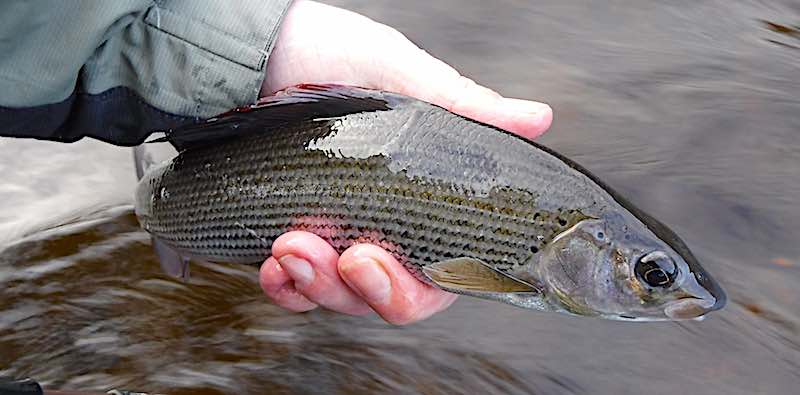
On bitterly cold days, you can fish a known grayling holding pool without a take. However, later in the day, they may switch on, and you’ll start catching. This often occurs when there’s a subtle temperature increase.
For example, the sun appears and/or there is a drop in wind.
Basically, don’t….
Give up until it’s time to go home.
Winter fly fishing tackle for Grayling:
If you fly fish for trout on rivers, you’re likely to have all the essential fishing tackle needed. The various types of fly rods, reels, fly lines, etc. I use for grayling fishing is outlined below.
Grayling fly fishing rod & reel
You can fly fish for grayling using dry flies, wet flies, and nymphs with a standard 9 or 10-foot fly rod rated from 3 to 7 wt and a well-matched reel.
I favour a soft-action, 9ft-6″ 5wt rod for dry and wet fly fishing for grayling. For Euro / Czech nymphing, I use a lightweight 10 to 11ft 3# fly rod. Currently, I prefer an 11ft 3# Vision Nymphmaniac fly rod paired with a Vision XLV nymph reel.

Fly Lines
Your fly line and rod should be matched. I use an Airflo Lake Pro WF5 floating line for wet and dry fly fishing. Nymphing can be done with a standard dry fly line and a fly rod. However, I use a low-diameter (0.6mm) speciality nymphing fly (Airflo SNF Euro Nymph) in windy conditions because it helps bite detection.
Leader & Tippet
I use a 12ft copolymer or monofilament 3X tapered leader with 3ft of 3 or 4 lb fluorocarbon tippet for grayling dry fly fishing. On windy days, swap the 12ft leader to a 9ft 3X tapered leader.
When fishing a team of three wet flies or spiders I use a 7ft copolymer or monofilament 5X tapered leader and add 6ft of 3 copolymer tippet for two droppers.
For Euro / Czech nymphing use a simple leader system composed of 6 to 9ft of 4lb fluorocarbon (Airflo Sightfree G3 Fluorocarbon), with 2 or 3 droppers spaced 18″ apart.
Fly fishing accessories:
- A landing net with a magnet release clipped on the back of your jacket
- A bottle of dry fly floatant – I use Gink
- Line degreaser – I use Fulling Mill Fuller’s Mud
- Something to dry the fly – I use a dry microfiber cloth
- Insulated waders
- Neoprene gloves and warm clothing for when it gets cold.
Now the essential grayling fishing tackle requirements are covered, let’s get into the ‘MEAT’ of fly fishing for grayling during the winter months…
When to go winter fly fishing for grayling?
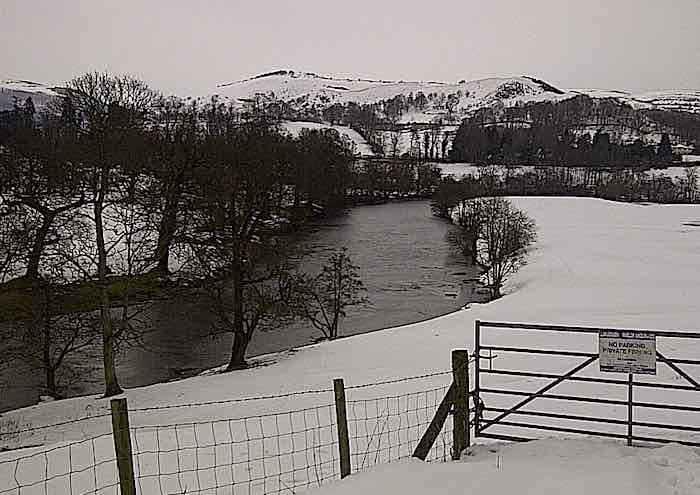
UK weather from December to February is a very variable beast.
Temperature-wise it can range from a very mild 15oC to a bitterly cold -10oC and below when the beast from the east blows.
In my younger days, if it was possible to get to the river, I could be found fly fishing for grayling in most weather conditions, but I wouldn’t recommend…
Fishing in sub-ZERO conditions to a beginner.
Stay at home if the daytime air temperature is NOT forecast to rise above freezing. That’s what I do while waiting for the weather to warm up.
How to find grayling when fly fishing in winter?
Grayling begin to shoal when the temperature drops and thus are not evenly distributed through the river.
For a successful day’s fishing, the first task is to locate where they are residing. This is not as difficult as it might first seem if you think in terms of their primary needs:
- Food, and
- Sanctuary.
Generally, a good winter grayling pool will contain one or more of the following features:
- The riverbed is composed of pebbles and/or gravel because this contains the food store that grayling can grub around in.
- Fast, bumpy water (riffle) above the head of the pool, which slows as the pool deepens and ideally forms a fast/slower water seam.
- A gentle glide section and/or back-eddy that offers sanctuary from the main flow when the river is in flood.
- Weed beds provide shelter and a food store.
- Pool tails where the flow increases and is broken by ledges and/or rocks.
Duncan’s pool on the Welsh Dee at Llangollen is a great example of a grayling pool for winter fly fishing because it contains most of the features described above.
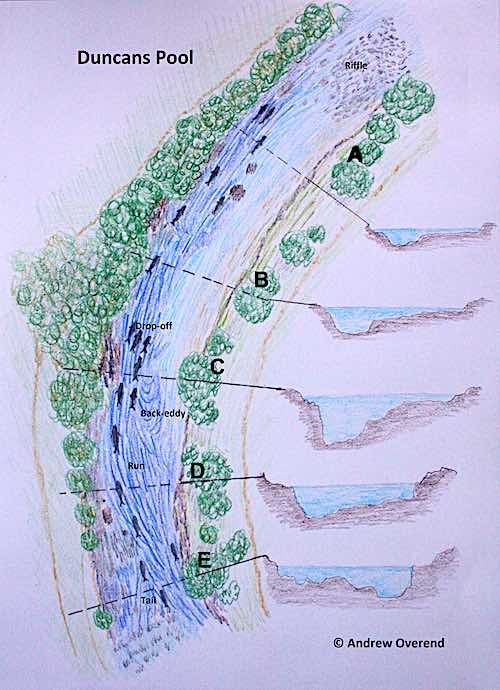
The above sketch of Duncan’s Pool shows where grayling are caught when the river is close to its summer level:
- Slack pockets of water behind boulders in the riffle section
- The drop-off zone at the head of the main pool
- Close to the rock ledges at the tail of the pool
When the river is in flood grayling seek the sanctuary of the slacker water close to the inside bend of the main pool.
Other examples of grayling holding pools on the Welsh Dee include:
Studying the layout of those pools will increase your understanding of what type of pools hold grayling, which you can apply to other rivers.

How to fly fish for grayling in winter?
The days are short with about 5 hrs of fishing. Therefore, it’s best to have a plan of where and how to fish for grayling.
Once I’ve selected the pools, I follow a simple, flexible approach to my grayling winter fly fishing…
On mild mornings, dry fly fishing is my preference when I’m faced with grayling taking flies at the surface.
If after c.a. 30 minutes I’ve failed to catch anything, I switch to fishing a team of wet flies close to the surface.
However, on most cold mornings there will be no sign of surface activity until after mid-day. Therefore, I begin by fishing a team of nymphs close to the riverbed on a short line (i.e. Euro nymphing, Czech nymphing).
Normally I fish the pool quickly and methodically because the days are short.
If grayling are feeding, it won’t be long before one is hooked. Then I slow my progress to ensure every inch of that area is fished because there will be others lurking nearby.
As the day progresses, I watch for signs of grayling feeding close to the surface. Usually, this will occur around mid-day and may last from a few minutes to an hour or so.
At that point, catching grayling on nymphs slows, and I switch to fishing either a team of wet flies or the dry fly can produce some great sport.
Eventually, dry and/or wet fly fishing stops working, and it’s time to revert to nymphing for the remainder of the day.
The above winter fly fishing approach has helped me catch plenty of fish on nymphs, wet flies and dry flies.
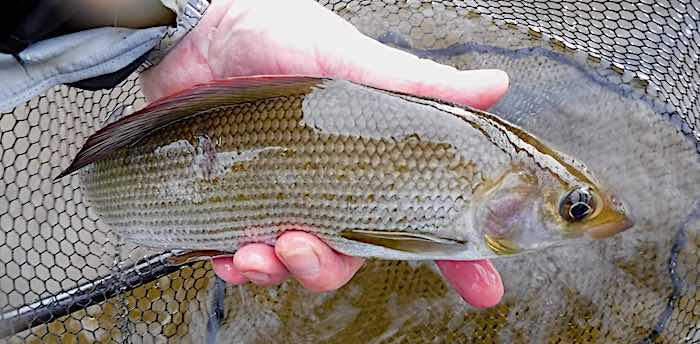
Short line nymphing for grayling
Grayling are predominately bottom feeders because that is where over 95% of their food is found. During winter, developing invertebrates (e.g. caddis larvae, nymphs, shrimps, etc) close to the riverbed keep grayling supplied with food.
Techniques such as Czech and French nymphing have been designed specifically for fishing flies on the bottom and are perfect for fly fishing for grayling.
Therefore, it’s not surprising that nymph fishing techniques are effective at catching grayling. It’s essential to master these fishing methods, or you’ll have many blank days.
Fortunately, it’s not that difficult to become proficient at short-range nymphing techniques it just needs a little practice.
Below is a link which discusses it in more detail and includes tackle requirements, leader set-up, and a selection of nymphs for different river and weather conditions.
Wet fly fishing in winter for grayling
On mild days when there is a hatch of flies, you can have some great sport fishing for grayling with wet flies and spiders.
Fly hatches are usually limited to the warmest part of the day and can be brief affairs. However, grayling often responds with a surface-feeding frenzy while the hatch lasts.
On the Welsh Dee in January, I’ve had sessions where 10+ grayling were caught fishing a team of spiders in an hour. So, keep an eye out for them.
For more on my approach to wet and spider fly fishing check out the following posts
Dry fly fishing in winter for grayling
Often, grayling will take the opportunity to feast on emerging flies on mild days (ca. > 8oC). Especially, a hatch of large dark olives in January and February. So, be prepared to cover them with a suitably matched dry fly.
Important note, grayling are more discerning than trout and will refuse a dragging fly; even micro-drag.
It is best to match the hatch but when this isn’t possible, I’ve had some good results using the following dry flies.
When small midges are hatching I found the trusty Griffith’s Gnat will often catch a few grayling.
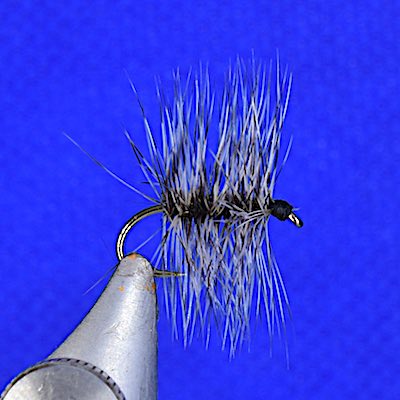
- Hook: Kamasan B170 size 18
- Thread: Black UNI 8/0
- Body: Peacock herl
- Hackle: palmered Grizzle cock
When olives are being taken at the surface the following fly pattern in sizes 14 and 16 often catches plenty of grayling
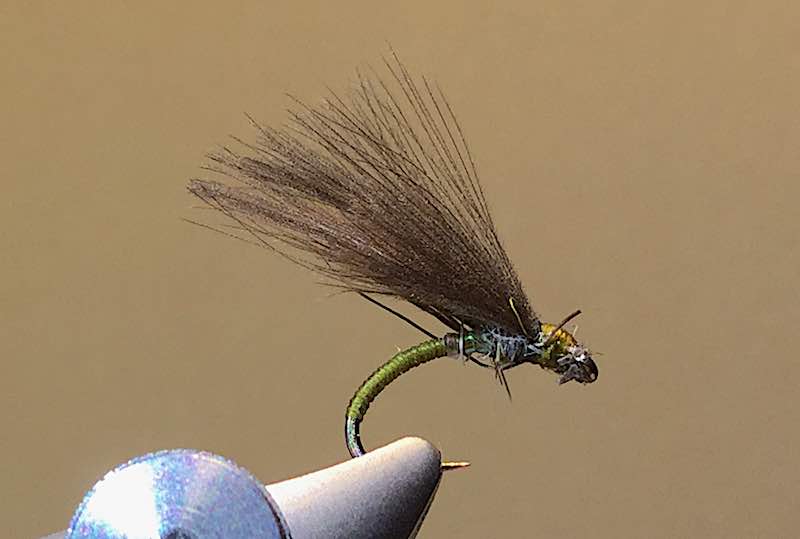
- Hook: Kamasan B100 #14 & 16
- Thread: Olive UNI-Thread 8/0
- Thorax: Hare’s ear dubbing
- Wing: 3-4 CDC feathers
Surprisingly, I’ve found that the crumpled iron blue emerger and the grayling ice-blue dry flies will tempt grayling off the riverbed. Even on a cold miserable day when there’s no sign of fly life on the water.

Crumpled Iron Blue emerger
- Hook: Kamasan B170 #16 & 18
- Thread: Grey UNI-Thread 8/0
- Tail: Grey Anton yarn
- Body: Mole fur
- Indicator: Orange Anton
- Hackle: Crumpled Iron Blue cock
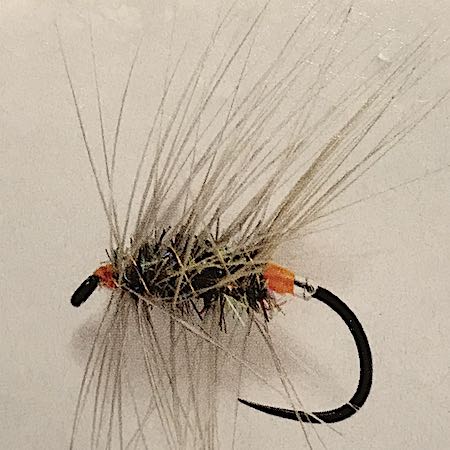
Grayling Ice-blue
- Hook: HENDS 454 #16 & 18
- Thread: Uni 8/0 orange
- Tag: silver tinsel & 2 turns of Glo-Brite orange
- Body: Ice blue HENDS Spectra dubbing
- Rib: Fine gold wire
- Hackle: Palmered Iron Blue cock
Further reading on flies for winter grayling fishing
Also, I’ve added links to posts on winter grayling fishing trips, which illustrate how to put the grayling fishing tips into practice.
- Fishing for grayling in Jan & Feb
- Grayling fishing in December on the Welsh Dee and River Eden
- Fishing the River Derwent for beautiful ladies
- Llandderfel Grayling fishing – a great day out on the Dee
- Grayling fishing at Rhagatt Hall
Take care of your catch when winter fly fishing
Grayling have soft mouths compared to trout and a big grayling hooked in fast water is a difficult fish to land safely.
It’s important not to bully grayling, or the hook will tear its mouth, just let it take line until you can guide it into slacker water and safely to the net.
Although grayling are fairly hardy, you should always take care when releasing them:
- Minimise the time they spend out of the water,
- Ideally, unhook them in a net that is in the water,
- Handle them with wet hands and avoid squeezing them,
- Full revive the fish in a gentle current before releasing.
Finally, I hope you have found this article on winter fly fishing for grayling interesting, and if you want to practice this learning there is some excellent grayling day ticket water on the Welsh Dee.
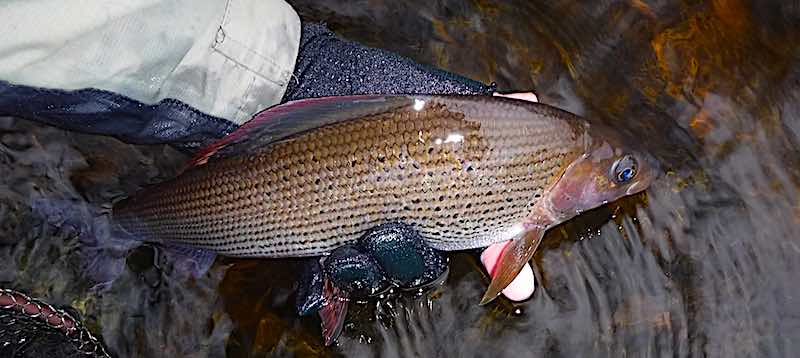
Really enjoy your articles Andrew , I used to hold a salmon permit on the Maelor fishing Sunbank when the footbridge was still there , I think Victor Whitworth was the owner then , the river produced plenty of salmon and big browns . I remember a 30plus salmon coming out below Maelor on the Wynstay section . Anyhow many thanks for the blogs it does take me back reading your description
Jimmy
Hi James,
The Broken Bridge Pool still produces some good salmon and a few big brown trout. There was a 5lb brown trout caught there this year but sadly the angler took it home. I’ve caught a few trout to 3lb there over the last couple of years and hopefully, they will get bigger.
It’s great to hear you are enjoying the blog posts. Cheers, Andrew
Perfect timing for your blog, Wednesday 17th we decided to try the chain pool at Corwen, there was a cool breeze whipping across the valley. The river was 0.566 pretty perfect, so I thought weighted leader , 3.8mm nymph on point and a couple of lighter flies above, not a thing, only lifting leaves. Went to Taylor’s pool and the wires, I fished the wires, this was about 11am, I’d just got in and noticed a small amount of flies emerging, I got out immediately and changed my rig minimal weight on point and middle then an emerger on top. Second cast bang 42cm grayling, beauty red tinges on fin, wished I’d have had my go pro. So it was exactly as you said, a slight increase in temperature and you could be in for a nice hour or so.
keep the blogs coming Andrew, love reading them.
Pete
Hi Peter,
Great to hear the change in technique caught you a lovely grayling.
Cheers, Andrew
Hi Andrew. Thanks for this article. You refer to a red nymph with a purple TB. Do you have a dressing for this pattern ? Going to go with your Czech nymphing set up and try it on the Wharfe.
Hi Geoff,
The following post has a pattern for that red nymph.
https://hawker-overend.com/best-grayling-flies-for-december-fly-fishing/
I hope it works on the Wharfe, Andrew
Hi Andrew
By coincidence I was fishing this exact swim yesterday, albeit not catching until I moved slightly further downstream, about 15 yards down from the two fences guarding the drain inlet where the water deepens a little.
I was kind of wading into the edge then fishing out into the deeper water. I notice that you appear to be standing mid river and casting either side of yourself. My question is whether you wade straight out there or first fish in the margins and then gradually wade out if you don’t catch?
Or do you wade straight out and then fish across and down from the middle – if so do you worry about scaring fish as you wade out (although I am coming to realise that grayling are not actually that wary of our presence compared to other fish)?
I’m still getting used to this wading business (I’ve previously only done it when long-trotting a float where its no the same issue as you tend to fish some way down from your position in the river) so any help gratefully received.
Kind regards
Kevin
Hi Kevin,
When nymphing I start fishing through the shallows first and work my way slowly across the river. It’s surprising how many grayling are caught in less than 1ft of water. If you’re careful wading tends not to bother grayling especially if they are feeding. In that pool, my friend made a short video of grayling swimming between my legs, presumably feeding on things my feet had disturbed.
I hope this helps, Andrew
Hi Andrew, great article. I also use an electric hand warmer kept in one of my handwarmer pockets on my Simms jacket. It stays hot for over 6 hours and helps keep my core warm as well as my stripping hand. The one I use is made by Lifesystems. You seem to fish the same way as I do on the Taff. My go to fly is a black F fly in size 14 or 16. Many thanks for the article and tight lines.
Hi Alan,
Thanks for the tips about hand warmers – I might have to give them a try when the weather turns nasty.
Great to hear you enjoyed the article. Cheers, Andrew
Great post Andrew and reminds me its high time I got out there!
R.Dove for me and boy does it have some cracking grayling in it.
Hi Charles,
All the tips will work on the Dove, so good luck.
Cheers, Andrew
Hi Andrew as always I always enjoy your article, I have posted it tioFB and especially to a couple of mates one who is newish to catch grayling on the fly. Cheers, all the bast. Dave
Hi Dave,
Great to hear you enjoyed it and thanks for sharing it with your friends.
Tight lines, Andrew
you’re very welcome and thank you
Thank you so much Andrew for sharing your experience , absolutely precious your tips and advices , is really a challenge winter grayling fishing but our endurance is often rewarded with great satisfatcions , I’m fishing in the coldest months with micro nymphs tied on 20 or 22 hook , even if sometimes surprisingly I catched some with Czech nymphs on 10 hook size .
Lodovico
Hi Lodovico,
It is interesting that you are using miro-nymphs during the cold months. I rarely have to go below a size 18. Usually, a size 16 or 14 will catch grayling on the Welsh Dee but that’s probably because the natural food on the river bed is about that size.
Thanks for your comments and good to hear you enjoyed the post. Cheers, Andrew
Thanks Andrew, another really good article, you should write a book to save me keep printing articles off!
Hi Nick,
Thanks for the great feedback.
Cheers, Andrew
Hi Andrew, thanks for your ongoing blogs and detailed articles for Llangollen beats.
Most of your articles and blogs suggest fishing is best at summer river levels, or in a few cases, between 0.7-1m.
I was wondering if you recommend beats for winter grayling fishing when the river is at current levels of 1-1.1m (Corwen) and dropping? Levels rise quickly and fall slowly at this time of year but good fishing must be available in falling and slightly coloured water.
Perhaps a blog or techniques article dedicated to winter river fishing as above?
Hi Phil,
I normally use the Manley Hall gauge as a guide on which pools to fish. When the river is at around 1m at Corwen there are only a couple of places I would fish at Llangollen (Dee Farm, Broken Bridge Pool). Not sure where would be OK at Corwen but you are looking for the larger pools and fish the inside bend, or any back eddies.
I hope this helps, Andrew
can i fly fish scottish river in december
I think so
Hello Andrew,
thank you for the wealth of information. I am new to using fly tackle so read up on it when I can. You share a great deal of knowledge without making it difficult to understand. It seems to me that everything I need to know is in your head. Have you written any books?
Hi Nick,
Great to hear you have found the website useful. I haven’t written any books but the website should help you get to grips with fly fishing.
Andrew